CONCEPTS IN BIOLOGY
PART V. THE ORIGIN AND CLASSIFICATION OF LIFE
23. The Animal Kingdom
23.14. Adaptations to Terrestrial Life
There is fossil evidence of land plants and fungi at about 480 million years ago, during the Ordovician period, and vascular plants were well established on land by the time terrestrial animals show up in the fossil record at about 420 million years ago. Thus, plants and fungi served as a source of food and shelter for the animals.
All animals that live on land must overcome certain common problems. Terrestrial animals must have:
1. a moist membrane that allows for an adequate gas exchange between the atmosphere and the organism,
2. a means of support and locomotion suitable for land travel,
3. methods to conserve internal water,
4. a means of reproduction and early embryonic development in which large amounts of water are not required, and
5. methods to survive the rapid and extreme climatic changes that characterize many terrestrial habitats.
When the first terrestrial animals evolved, there were many unfilled niches; therefore, much adaptive radiation occurred, resulting in a large number of different animal species. Of all the many phyla of animals in the ocean, only a few made the transition from the ocean to the extremely variable environments found on the land. The annelids (earthworms and leeches) and the mollusks (land snails) have terrestrial species but are confined to moist habitats. Many of the arthropods (centipedes, millipedes, scorpions, spiders, mites, ticks, and insects) and vertebrates (reptiles, birds, and mammals) adapted to a wide variety of drier terrestrial habitats.
Terrestrial Arthropods
There are five kinds of terrestrial arthropods: crustaceans, millipedes, centipedes, arachnids (mites, ticks, spiders, scorpions), and insects. The few terrestrial crustaceans are generally confined to moist environments. The first terrestrial animals were millipedes, which are known from the fossil record from over 400 million years ago. Flightless insects also are early terrestrial organisms. The exoskeleton of marine arthropods was important in allowing some of their descendents to adapt to land. It provides the support needed in the less buoyant air and serves as a surface for muscle attachment that permits rapid movement. The exoskeleton of most terrestrial arthropods has a waterproof, waxy coating that reduces water loss.
Terrestrial arthropods have an internal respiratory system that prevents the loss of water from their respiratory surface. They have a tracheal system of thin-walled tubes extending into all regions of the body, thus providing a large surface area for gas exchange (figure 23.31a). These tubes have small openings to the outside, which reduce the amount of water lost to the environment. Another important method of conserving water in insects and spiders is the presence of Malpighian tubules, thin- walled tubes that surround the gut and reabsorb water from nitrogenous wastes prior to their excretion (figure 23.31b).
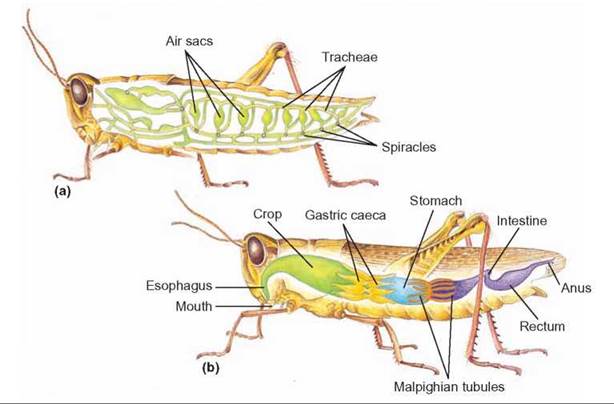
FIGURE 23.31. Insect Respiratory and Waste-Removal Systems
(a) Spiracles are openings in the exoskeleton of insects and other terrestrial arthropods. These openings connect to a series of tubes (tracheae) that allow for the transportation of gases in the insect’s body. (b) Malpighian tubules are used in the elimination of waste materials and the reabsorption of water into the arthropod body. Both systems are means of conserving body water.
Internal fertilization is typical of terrestrial arthropods. It involves copulation, in which a penis is used to insert the sperm into the reproductive tract of the female (insects, millipedes) or the production of special sperm-containing sacs (spermatophores) that are picked up by the female (spiders, centipedes). This is important because both the sperm and egg are protected from drying.
Terrestrial arthropods have evolved a number of characteristics that assure their survival under hostile environmental conditions. Many seek out sheltered sites and become inactive during periods of cold or drought. Often this involves changes in physiology that protect against freezing or prevent water loss. In addition, their rapid reproductive rate can replace the large number that die. Most of a population may be lost because of an unsuitable environmental change, but, when favorable conditions return, the remaining individuals can quickly increase in number. Many have complex life cycles that involve larval stages that occupy different niches from the adults. For example, butterflies have larval stages that feed on the leaves of plants and grow rapidly. The adults feed on the nectar of flowers and are primarily involved in sexual reproduction that involves mating and laying of the eggs on appropriate host plants (figure 23.32).

FIGURE 23.32. The Life History of a Monarch Butterfly
The adult female lays eggs on a milkweed plant. The fertilized egg hatches into the larval stage, known as a caterpillar, which feeds on the leaves of the milkweed plant. The caterpillar grows and eventually metamorphoses into a pupa. After emerging from the pupa, the adult’s wings expand to their full size. The adults feed on the nectar of flowers. After mating, the female lays eggs and the life cycle starts over again.
The terrestrial arthropods occupy an incredible variety of niches. Many insects are herbivores that compete directly with humans for food. They are capable of decimating plant populations that serve as human food. Many farming practices, including the use of pesticides, are directed at controlling insect populations. Other kinds of insects, as well as spiders and centipedes, are carnivores that feed primarily on arthropods and other small animals. Mites and millipedes feed primarily on decaying material and the fungi and bacteria that are part of decaying material. Insects have evolved in concert with the flowering plants; their role in pollination is well understood. Bees, butterflies, and beetles transfer pollen from one flower to another as they visit the flowers in search of food. Many kinds of crops rely on bees for pollination, and farmers even rent beehives to ensure adequate pollination for fruit production.
Terrestrial Vertebrates
The first vertebrates on land were probably the ancestors of present-day amphibians (frogs, toads, and salamanders). The endoskeleton of vertebrates is an important prerequisite for life on land. It provides the support in the air and provides the places for muscle attachment necessary to movement. However, appendages are needed to move about. Certain bony fishes have lobe-fins, which can serve as primitive legs. It is likely that the amphibians evolved from a fish with modified fins (How Science Works 23.2). The first amphibians made the transition to land about 360 million years ago during the Devonian period. This was 50 million years after plants and arthropods had become established on land. Thus, when the first vertebrates developed the ability to live on land, shelter and food for herbivorous as well as carnivorous animals were available. But vertebrates faced the same problems that the insects, spiders and other invertebrates faced in their transition to life on land.
HOW SCIENCE WORKS 23.2
Coelacanth Discoveries
Sometimes, scientific discoveries are made because the right person is in the right place at the right time. In 1938, a coelacanth—a fish that was thought to have been extinct for about 80 million years—was discovered near the mouth of the Chalumna River on the east coast of South Africa. The fishing boat captain who caught the fish contacted Marjorie Courtney-Latimer, the director of the local museum in the town of East London. She immediately contacted a fish biologist, J. L. B. Smith, and the coelacanth became a scientific celebrity. The coelacanth was named Latimeria chalumnae, incorporating both Courtney-Latimer's name and the name of the Chalumna River in its name. Subsequently, it was discovered that the fish was probably a stray and that the center of the population was farther north in the waters between Mozambique and the island of Madagascar.
In 1997, a biologist, Mark Erdmann, saw a coelacanth in a market in Indonesia. He photographed the fish and questioned the fishers. He then returned to Indonesia and, over a 5-month period, interviewed over 200 fishers. Eventually, he discovered two fishermen who occasionally caught coelacanths. Eventually, he was rewarded with a live specimen, and it was eventually described as a new species, Latimeria menadoensis. Scientists used structural differences and DNA analysis as evidence that the Indonesian coelacanth was a different species from the African species.
What was once thought to have been extinct for 80 million years can now be studied in the flesh. Over 200 specimens have been captured, and diving submarines have been used to observe coelacanths in the wild. They live in deep water and typically stay in caves during the day.
The coelacanth has several characteristics that make it of interest to biologists. Primary among them is the presence of lobe fins. The fins are on short, limblike appendages that resemble stubby legs. Because of this, many biologists thought that coelacanths may have been the ancestors of terrestrial, four-legged vertebrates. Although most no longer feel this is the case, coelacanths do have several interesting characteristics. When they swim, they move their fins alternately in a manner similar to the way four-legged animals walk. They do not have a vertebral column but have a notochord that serves the same purpose as a spine. They have internal fertilization and the young develop from large eggs that are retained within the body of the mother and are born when they have completed development.
Sometimes accidental discoveries lead to a new body of scientific information.
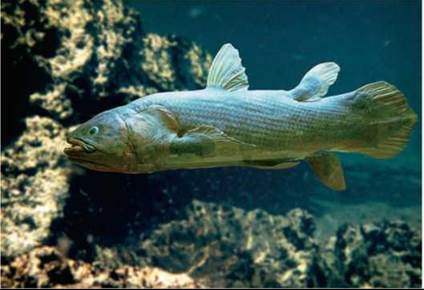
Amphibians
Amphibians are only minimally adapted to a terrestrial life. Although they have lungs they do not have an efficient method of breathing. They swallow air to fill the lungs and are able to accomplish some exchange of oxygen and carbon dioxide. However, most gas exchange occurs through their moist skin. In addition to needing water to keep their skin moist, amphibians must reproduce in water. When they mate, the female releases eggs into the water, and the male releases sperm amid the eggs. External fertilization occurs in the water, and the fertilized eggs must remain in water or they will dehydrate. Thus, amphibians live on “dry” land but are not found far from water, because they lose water through their moist skin and reproduction must occur in water. The most common present-day amphibians are frogs, toads, and salamanders (figure 23.33).
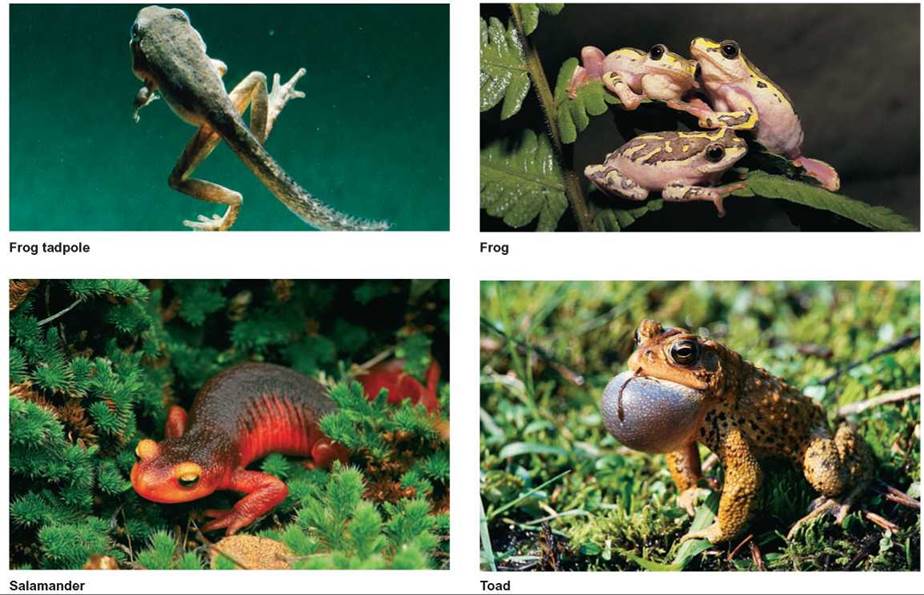
FIGURE 23.33. Amphibians
Amphibian larvae (tadpoles) are aquatic organisms that have external gills and feed on vegetation. Most adult salamanders, frogs, and toads feed on insects, worms, and other small animals.
Reptiles
For 40 million years, amphibians were the only vertebrate animals on land. However, eventually they were replaced by reptiles, which were better adapted to life on land. In addition to having internal lungs, reptiles have a waterproof skin and water-conserving kidneys to reduce water loss. Furthermore, their reproduction involves internal fertilization, which protects the egg and sperm from drying. However, to be truly free of water it is necessary to have a specialized aquatic environment in which the embryo develops. This is accomplished with a special reproductive development known as an amniotic egg.
Reptiles became completely independent of an aquatic environment with the development of the amniotic egg, which protects the developing young from injury and dehydration (figure 23.34). The covering on the egg retains moisture and protects the developing young from dehydration while allowing for the exchange of gases. The reptiles were the first animals to develop such an egg.

FIGURE 23.34. The Amniotic Egg
An amniotic egg has a shell and a membrane that prevent the egg from dehydrating but still allow for the exchange of gases between the egg and the environment. The egg yolk provides a source of nourishment for the developing young. The embryo grows three extraembryonic membranes: the amnion is a fluid-filled sac that allows the embryo to develop in a liquid medium, the allantois collects the embryo’s metabolic waste material and exchanges gases, and the chorion is a membrane that encloses the embryo and the other two membranes.
The development of a means of internal fertilization and the amniotic egg allowed the reptiles to spread over much of the Earth and occupy a large number of previously unfilled niches. For about 200 million years, they were the only large vertebrate animals on land. The evolution of reptiles increased competition with the amphibians for food and space. The amphibians generally lost in this competition; consequently, most became extinct. Some evolved into present-day frogs, toads, and salamanders.
In a similar fashion, as birds and mammals evolved, many kinds of reptiles became extinct. However, there are still many kinds of reptiles present today. They include turtles, lizards, snakes, crocodiles, and alligators (figure 23.35).
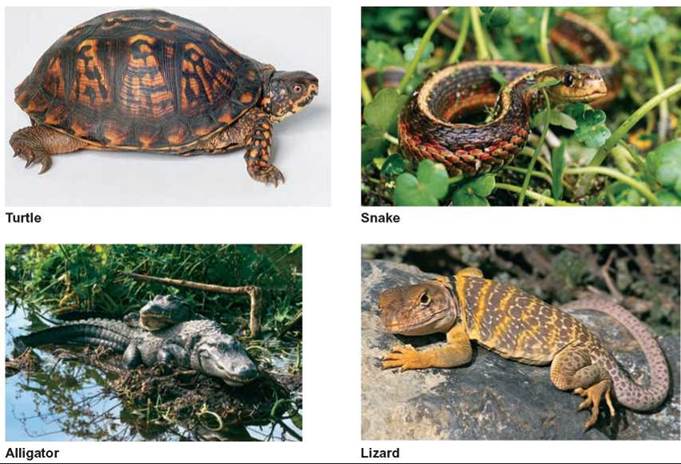
FIGURE 23.35. Reptiles
Present-day reptiles include turtles, crocodiles and alligators, snakes, and lizards.
Birds
The reptiles gave rise to two other groups of vertebrates: birds and mammals. About 65 million years ago, a mass extinction of many kinds of reptiles occurred. At that time, birds and mammals began to diversify and became the dominant forms of vertebrates on land. Like the structures of their reptile ancestors, the skin, lungs, and kidneys of birds reduce water loss, and reproduction involves internal fertilization and the shelled amniotic egg.
They also have other adaptations that allow them to be successful as land animals. Birds are homeothermic and have feathers. As homeotherms, they have a high body temperature and a more rapid metabolic rate than reptiles. Feathers serve two primary functions in birds. They form an insulating layer, which helps prevent heat loss, and they provide structural surfaces enabling the birds to fly. There are several values to flight. Animals that fly are able to travel long distances in a short time and use less energy than animals that must walk or run. They are able to cross barriers, such as streams, lakes, oceans, bogs, ravines, or mountains, that other animals cannot easily cross. They can also escape many kinds of predators by taking flight quickly.
The exploitation of flight has shaped the entire structure and function of birds. The forelimbs are modified into wings for flight, although it is actually the flight feathers that provide most of the flight surface. Large breast muscles provide the power for flight. Feathers help provide a streamlined shape. Homeothermism enables a high constant temperature, which allows for the rapid wing beats typical of most birds. In addition, the skeleton is reduced in weight and the jaws lack teeth that are heavy. The beak performs some of the functions of the teeth and is lighter. Birds have successfully occupied many niches. Some are nectar feeders, some are carnivores, some are seedeaters, some are aquatic, and some have even lost their ability to fly (figure 23.36).
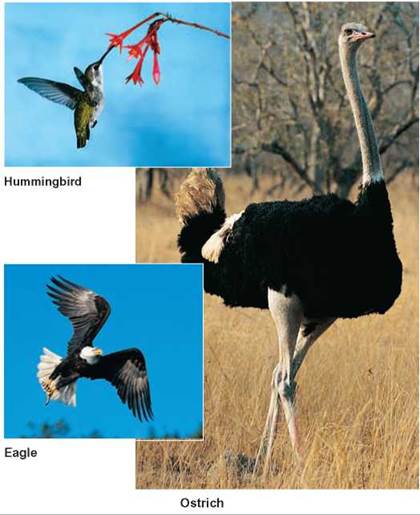
FIGURE 23.36. Birds
Birds range in size from the small hummingbird with a rapid wingbeat to the large, flightless ostrich. In food habits, they range from the nectar-feeding hummingbird to the omnivorous ostrich and the carnivorous eagle.
Because they are homeotherms, birds’ eggs must be kept at a warm temperature. Thus, birds build nests, incubate their eggs, and care for their young.
Mammals
The first mammals appeared about 200 million years ago, when reptiles were at their most diverse. Like birds, mammals are homeotherms, with a high constant body temperature. Like reptiles and birds, they have a waterproof skin and water-conserving lungs and kidneys. However, they differ from birds in several respects. Their insulating covering is hair, rather than feathers, and they provide nourishment to their young with milk produced by special glands.
There are three categories of mammals. Monotremes (platypus and echidna) are egg-laying mammals whose young still develop in an external egg. Following hatching, the mother provides nourishment in the form of milk. The milk glands are widely distributed on her underside, and the young lap up the milk from her fur.
Marsupials (pouched mammals) have internal development of the young. However, the young are born in a very immature state and develop further in an external pouch in the belly region of the female. In the pouch, the young attach to a nipple. They continue their development and eventually begin to leave the pouch for periods of time until they are able to forage for themselves.
Placental mammals have a form of development in which the young remain within the female much longer. The embryo is attached to the wall of the uterus by an organ known as a placenta. In the placenta, capillaries from the circulatory systems of the mother and embryo are adjacent to one another. This allows for the exchange of materials between the developing young and the mother, and the young are born in a more advanced stage of development than is typical for marsupials. The young rely on milk as a source of food for some time before they begin to feed on their own (figure 23.37).

FIGURE 23.37. Mammals
All mammals have hair and produce milk. However, there are three, very different kinds of mammals. Monotremes lay eggs. Marsupials have pouches; the young are born in an immature stage and are carried in the pouch while they finish their development. Placental mammals have a placenta, which connects the mother and embryo; they retain the young in the uterus for a longer period of time.
23.14. CONCEPT REVIEW
33. List the problems animals had to overcome to adapt to a terrestrial environment.
34. List four adaptations of arthropods that allow them to be successful terrestrial animals.
35. Why can’t amphibians live in all types of terrestrial habitats?
36. What is the importance of the amniotic egg?
37. How does a marsupial differ from a placental mammal?
Summary
The 4 million known species of animals, which inhabit widely diverse habitats, are all multicellular and heterotrophic. Animal body shape is asymmetrical, radial, or bilateral. All animals with bilateral symmetry have a body structure composed of three layers.
Animal life originated in the ocean about 600 million years ago; for the first 200 million years, all animal life remained in the ocean. Many simple marine animals have life cycles that involve alternation of generations.
Many kinds of flatworms and nematodes have a parasitic lifestyle with complicated life cycles. A major ecological niche for many marine animals is the ocean bottom—the benthic zone. Many marine animals are planktonic. These zooplankton feed on phytoplankton and, in turn, are fed upon by larger, free-swimming marine animals—the nekton.
Animals that adapted to a terrestrial environment had to have (1) a moist membrane for gas exchange, (2) support and locomotion suitable for land, (3) a means of conserving body water, (4) a means of reproducing and providing for early embryonic development out of water, and (5) a means of surviving in rapid and extreme climatic changes.
Basic Review
1. The most abundant group of terrestrial animals is the
a. mammals.
b. birds.
c. earthworms.
d. insects.
2. The sponges and cnidarians
a. reproduce sexually.
b. are primarily marine.
c. are not bilaterally symmetrical.
d. All of the above are correct.
3. Which of the following animal groups shows radial symmetry?
a. annelids
b. echinoderms
c. vertebrates
d. None of the above is correct.
4. The most successful group of animals based on the number of species is the _____.
5. The three general parts of the mollusk body are the visceral mass, mantle, and _____.
6. Nematode worms are extremely common in soil. (T/F)
7. Which of the following organisms has a body consisting of a linear arrangement of similar segments?
a. nematodes
b. mollusks
c. annelids
d. cnidarians
8. All of the following animals have an amniotic egg except
a. monotremes.
b. marsupials.
c. reptiles.
d. birds.
9. Terrestrial animals have
a. internal fertilization.
b. a waterproof skin.
c. a strong skeleton.
d. All of the above are correct.
10. The two groups of animals that are homeotherms are the _____.
11. Which of the following animals is diploblastic?
a. jellyfish
b. starfish
c. shark
d. mammal
12. Annelid worms are
a. diploblastic.
b. coelomate.
c. assymetrical.
d. homeotherms.
13. Most marine animals have a free-swimming developmental stage called a _____.
14. The flatworms are
a. triploblatic.
b. acoelomate.
c. poikilotherms.
d. All of the above are correct.
15. Nematodes have a body cavity known as a _____.
Answers
1. d 2. d 3. b 4. arthropods 5. foot 6. T 7. c 8. b 9. d 10. birds and mammals 11. a 12. b 13. larva 14. d 15. Pseudocoelom
Thinking Critically
Using Animals in Research
Animals have been used routinely as models for the development of medical techniques and strategies. They have also been used in the development of pharmaceuticals and other biomedical products, such as heart valves and artificial joints. The techniques necessary to perform heart, kidney, and other organ transplants were first refined using chimpanzees, rats, and calves. Antibiotics, hormones, and chemotherapeutic drugs have been tested for their effectiveness and for possible side effects using laboratory animals that are very sensitive and responsive to such agents. Biologists throughout the world have bred research animals that readily produce certain types of cancers that resemble the cancers found in humans. By using these animals instead of humans to screen potential drugs, the risk to humans is greatly reduced. The emerging field of biotechnology is producing techniques that enable researchers to manipulate the genetic makeup of organisms. Research animals are used to perfect these techniques and highlight possible problems.
Animal rights activists are very concerned about using animals for these purposes. They are concerned about research that seems to have little value in relation to the suffering these animals are forced to endure. Members of the American Liberation Front (ALF), an animal rights organization, vandalized a laboratory at Michigan State University where mink were used in research to assess the toxicity of certain chemicals. Members of this group poured acid on tables and in drawers containing data, smashed equipment, and set fires in the laboratory. This attack destroyed 32 years of research records, including data used for developing water-quality standards. In 1 year, 80 similar actions were carried out by groups advocating animal rights. What type of restrictions or controls should be put on such research? Where do you draw the line between “essential” and “nonessential” studies? Do you support the use of live animals in experiments that may alleviate human suffering?